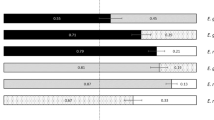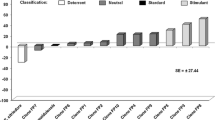Abstract
Thaumastocoris peregrinus is an insect pest that causes a reduction in the productivity of Eucalyptus. Control of this insect can be carried out through selection of its less preferred genetic materials. The aim of this research was to evaluate the preferences of T. peregrinus and to associate these with the biochemical composition of six genetic materials of Eucalyptus, collected in an experimental area of the Federal University of Technology - Paraná. Three bioassays were performed: Bioassay 1 conferred the feeding preference of adults of T. peregrinus, through a multiple choice test among the genetic materials; Bioassay 2 evaluated the confinement of the insects, observing the presence of insects, feces, and eggs on the leaves, for a five-day period; Bioassay 3: biochemical analyses were performed on leaves collected from the genetic materials in three different treatments. The preferred genetic material for feeding of T. peregrinus was Clone H-13 and the least preferred was Clone GFMO-27. In the confinement test, the highest percentage of live insects was on Eucalyptus propinqua and the lowest percentage on Eucalyptus pellita × Eucalyptus tereticornis. The biochemical levels of proteins, total and reducing sugars, and phenylalanine ammonia lyase (PAL) activity demonstrated specificity regarding changes after 24 h of exposure to T. peregrinus. In Clone H13, there was a greater increase in the activity of the PAL enzyme, demonstrating that there was a defense response on the part of the plant, however, not sufficient to deter the insects.

Similar content being viewed by others
Data availability
All data generated or analyzed during this study are included in this published article.
Code availability
Not applicable.
References
Abati R, Sampaio AR, Mendes R et al (2021) Bees and pesticides: the research impact and scientometrics relations. Environ Sci Pollut Res. https://doi.org/10.1007/s11356-021-14224-7
Action EES (2014) Action
Ballhorn DJ, Kautz S, Heil M (2013) Distance and sex determine host plant choice by herbivorous beetles. PLoS ONE 8:e55602. https://doi.org/10.1371/journal.pone.0055602
Brun EJ, Bersch AP, Pereira FA et al (2018) Caracterizção energética da madeira de três materiais genéticos de Eucalyptus sp. Floresta 48:87–92. https://doi.org/10.5380/rf.v48i1.51673
Carpinteiro DL, Dellapé PM (2006) A new species of Thaumastocoris Kirkaldy from Argentina (Heteroptera: Thaumastocoridae: Thaumastocorinae). Zootaxa 1228:61–68
Chaboussou F (1980) Les Plantes Malades des Pesticides. Editions Débard, Paris
Cuello EM, Andorno AV, Hernández CM, López SN (2019) Population development of the invasive species Thaumastocoris peregrinus (Hemiptera: Thaumastocoridae) on four Eucalyptus species of the subgenus Symphyomyrtus. Neotrop Entomol 48:152–161. https://doi.org/10.1007/s13744-018-0614-7
Desneux N, Decourtye A, Delpuech J (2007) The sublethal effects of pesticides on beneficial arthropods. Annu Rev Entomol. https://doi.org/10.1146/annurev.ento.52.110405.091440
Dubois M, Gilles K, Hamilton JK et al (1955) A colorimetric method for the determination of sugars. Anal Biochem 28:350–355
Gallo D, Nakano O, Silveira Neto S, et al (2002) Entomologia agrícola. FEALQ, Piracicaba
Garcia A, Figueiredo E, Valente C et al (2013) First record of Thaumastocoris peregrinus in Portugal and of the neotropical predator Hemerobius bolivari in Europe. Bull Insectol 66:251–256
Gonçalves JLM, Alvares CA, Higa AR et al (2013) Integrating genetic and silvicultural strategies to minimize abiotic and biotic constraints in Brazilian eucalypt plantations. For Ecol Manag 301:6–27. https://doi.org/10.1016/j.foreco.2012.12.030
Goulson D, Nicholls E, Botías C, Rotheray EL (2015) Bee declines driven by combined stress from parasites, pesticides, and lack of flowers. Science (80-). https://doi.org/10.1126/science.1255957
Jacobs DH, Neser S (2005) Thaumastocoris australicus Kirkaldy (Heteroptera: Thaumastocoridae): a new insect arrival in South Africa, damaging to Eucalyptus trees. S Afr J Sci 101:233–236
Lima ACV, Wilcken CF, Ferreira-Filho PJ et al (2016) Intra-plant spatial distribution of Thaumastocoris peregrinus Carpintero & Dellapé (Hemiptera: Thaumastocoridae) on Eucalyptus grandis plants. Phytoparasitica 44:411–418. https://doi.org/10.1007/s12600-016-0526-1
Lorencetti GAT, Mazaro SM, Potrich M et al (2015) Produtos Alternativos para Controle de Thaumastocoris peregrinus e Indução de Resistência em Plantas. Floresta e Ambient 22:541–548. https://doi.org/10.1590/2179-8087.066913
Lorencetti GAT, Potrich M, Mazaro SM et al (2018) Eficiência de Beauveria bassiana Vuill. e Isaria sp. para o controle de Thaumastocoris peregrinus Carpintero & Dellapé (Hemiptera: Thaumastocoridae). Ciência Florest 28:403–411. https://doi.org/10.5902/1980509831612
Machado DN, Costa EC, Garlet J et al (2016) Avaliação de inseticidas no controle de Thaumastocoris peregrinus (hemiptera: Thaumastocoridae) percevejo-bronzeado em condições de laboratório. Floresta e Ambient 23:245–250. https://doi.org/10.1590/2179-8087.144415
Martínez G, Finozzi MV, Cantero G et al (2017) Oviposition preference but not adult feeding preference matches with offspring performance in the bronze bug Thaumastocoris peregrinus. Entomol Exp Appl 163:101–111. https://doi.org/10.1111/eea.12554
Mazaro SM, Wagner Júnior A, dos Santos I et al (2009) Controle do tombamento de plântulas de beterraba e tomate pelo tratamento de sementes com quitosana. Pesqui Agropecuária Bras 44:1424–1430. https://doi.org/10.1590/s0100-204x2009001100008
Miller GL (1959) Use of dinitrosalicylic acid reagent for determination of reducing sugar. Anal Chem 31:426–428
Montemayor SI, Dellapé PM, Melo MC (2015) Geographical distribution modelling of the bronze bug: a worldwide invasion. Agric for Entomol 17:129–137. https://doi.org/10.1111/afe.12088
Nadel RL, Noack AE (2012) Current understanding of the biology of Thaumastocoris peregrinus in the quest for a management strategy. Int J Pest Manag 58:257–266. https://doi.org/10.1080/09670874.2012.659228
Oballa PO, Konuche PKA, Muchiri MN, Kigomo BN (2010) Facts on growing and use of eucalyptus in Kenya. KEFRI Kenya Forestry Research Institute, Nairobi, Kenya
Ohmart CP, Edwards PB (1991) Insect herbivory on Eucalyptus. Annu Rev Entomol 36:637–657. https://doi.org/10.1146/annurev.en.36.010191.003225
Pinto BGS, Soares TKM, Linhares MA, Ghisi NC (2020) Occupational exposure to pesticides: genetic danger to farmworkers and manufacturing workers—a meta-analytical review. Sci Total Environ 748:141382
Pizzaia WCS, Diniz TO, Silva BG et al (2021) Toxicological and morphological analysis of Africanized Apis mellifera selected for tolerance to the neonicotinoid thiamethoxam. Res Soc Dev 10:e143102122109
Polito WL (2006) The Trofobiose Theory and organic agriculture: the active mobilization of nutrients and the use of rock powder as a tool for sustainability. An Acad Bras Cienc 78:765–779. https://doi.org/10.1590/S0001-37652006000400011
Ramanagouda SH, Kumari NK, Vastrada S et al (2010) Potential alien insects threatening eucalyptus plantations in India, Karnataka. J Agric Sci 23:1–4
Rodrigues AAC, Neto EB, Coelho RSB (2006) Induced resistance to Fusarium oxysporum f. sp. tracheiphilum in cowpea plants: effectiveness of abiotic inducers and elicited enzymatic activity. Fitopatol Bras 31:492–499. https://doi.org/10.1590/S0100-41582006000500009
Saavedra MC, Avila GA, Withers TM, Holwell GI (2015a) The potential global distribution of the Bronze bug Thaumastocoris peregrinus Carpintero and Dellapé (Hemiptera: Thaumastocoridae). Agric for Entomol 17:375–388. https://doi.org/10.1111/afe.12117
Saavedra MC, Withers TM, Holwell GI (2015b) Susceptibility of four Eucalyptus host species for the development of Thaumastocoris peregrinus Carpintero and Dellapé (Hemiptera: Thaumastocoridae). For Ecol Manag 336:210–216. https://doi.org/10.1016/j.foreco.2014.10.024
Santadino M, Lucia A, Duhour A et al (2017) Feeding preference of Thaumastocoris peregrinus on several Eucalyptus species and the relationship with the profile of terpenes in their essential oils. Phytoparasitica 45:395–406. https://doi.org/10.1007/s12600-017-0593-y
Singh NS, Sharma R, Parween T, Patanjali PK (2017) Pesticide contamination and human health risk factor. In: Oves M, Khan MZ, Ismail IMI (eds) Modern age environmental problems and their remediation. Springer, Cham
Smaniotto MA, Da Silva A, Da Cunha US, Garcia MS (2017) Biologia de Thaumastocoris peregrinus carpintero e dellapé (Hemiptera: Thaumastocoridae) em dez espécies de eucalipto. Cienc Florest 27:679–685. https://doi.org/10.5902/1980509827752
Soliman EP, Wilcken CF, Pereira JM et al (2012) Biology of Thaumastocoris peregrinus in different eucalyptus species and hybrids. Phytoparasitica 40:223–230. https://doi.org/10.1007/s12600-012-0226-4
Soliman EP, de Castro e Castro BM, Wilcken CF et al (2019) Susceptibility of Thaumastocoris peregrinus (Hemiptera: Thaumastocoridae), a eucalyptus pest, to entomopathogenic fungi. Sci Agric 76:255–260. https://doi.org/10.1590/1678-992x-2017-0043
Sosa-Gómez DR, Omoto C (2012) Resistência a inseticidas e outros agentes de controle em artrópodes associados à cultura da soja. In: Soja Manejo integrado de insetos e outros Artrópodes-praga. Embrapa Soja, Londrina
Stenger LD, Abati R, Pawlak IG et al (2021) Toxicity of essential oil of Eugenia uniflora (L.) to Thaumastocoris peregrinus (Hemiptera: Thaumastocoridae) and selectivity to the parasitoid Cleruchoides noackae (Lin & Hubert) (Hymenoptera: Mymaridae). Crop Prot 147:105693
Swart RC, Samways MJ, Pryke JS, Roets F (2020) Individual tree context and contrast dictate tree physiological features and arthropod biodiversity patterns across multiple trophic levels. Ecol Entomol 45:333–344. https://doi.org/10.1111/een.12804
Tedesco FG, Lozano ER, Mazaro SM et al (2020) Potential of Beauveria bassiana formulations to control Thaumastocoris peregrinus (Hemiptera: Thaumastocoridae). Res Soc Dev 9:e969108097. https://doi.org/10.33448/rsd-v9i10.8097
Thomson VP, Nicotra AB, Steinbauer MJ (2001) Influence of previous frost damage on tree growth and insect herbivory of Eucalyptus globulus globulus. Austral Ecol 26:489–499. https://doi.org/10.1046/j.1442-9993.2001.01144.x
Tomasetto F, Tylianakis JM, Reale M et al (2017) Intensified agriculture favors evolved resistance to biological control. Proc Natl Acad Sci USA 114:3885–3890. https://doi.org/10.1073/pnas.1618416114
Volf M, Volfová T, Seifert CL et al (2022) A mosaic of induced and non-induced branches promotes variation in leaf traits, predation and insect herbivore assemblages in canopy trees. Ecol Lett 25:729–739. https://doi.org/10.1111/ele.13943
Acknowledgements
For Universidade Tecnológica Federal do Paraná (UTFPR), Coordenação de Aperfeiçoamento de Pessoal de Nível Superior (CAPES) and Conselho Nacional de Desenvolvimento Científico e Tecnológico (CNPq - 313244/2020-0) for promoting research.
Funding
For Universidade Tecnológica Federal do Paraná (UTFPR) for structure, equipment, materials and granting graduate scholarships, Coordenação de Aperfeiçoamento de Pessoal de Nível Superior (CAPES) and Conselho Nacional de Desenvolvimento Científico e Tecnológico (CNPq) for granting graduate scholarships.
Author information
Authors and Affiliations
Contributions
Conceptualization: MP and IGP; Methodology: MP, SMM, and FEC; Formal analysis and investigation: IGP, SD, FCC, RMAM, and CLP; Writing—original draft preparation: SD, IGP, and MP; Writing—review and editing: EJB, SMM, FEC, ERL, and RA; Funding acquisition: MP, ERL, and SMM; Resources: MP, ERL, SMM, and EJB; and Supervision: MP,
Corresponding author
Ethics declarations
Conflict of interest
The authors declare that they have no conflict of interest.
Additional information
Handling Editor: John J Couture.
Publisher's Note
Springer Nature remains neutral with regard to jurisdictional claims in published maps and institutional affiliations.
Rights and permissions
Springer Nature or its licensor (e.g. a society or other partner) holds exclusive rights to this article under a publishing agreement with the author(s) or other rightsholder(s); author self-archiving of the accepted manuscript version of this article is solely governed by the terms of such publishing agreement and applicable law.
About this article
Cite this article
Pawlak, I.G., Dallacort, S., Paloschi, C.L. et al. Preference of Thaumastocoris peregrinus (Hemiptera: Thaumastocoridae) and biochemical analysis of different genetic materials of Eucalyptus. Arthropod-Plant Interactions 18, 277–286 (2024). https://doi.org/10.1007/s11829-023-10027-4
Received:
Accepted:
Published:
Issue Date:
DOI: https://doi.org/10.1007/s11829-023-10027-4




